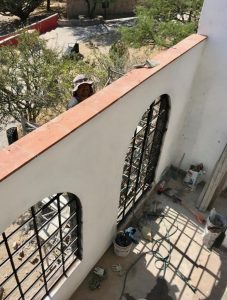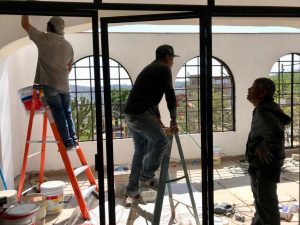A little after eight every weekday morning, the trabajadores trickle in, wearing hoodies against the morning chill and carrying hefty backpacks, no doubt containing their lunch. These workmen are unsung heroes to me, artists in their own right, who deserve applause. With their strong backs and hands these men made the place I now call home, mi hermoso refugio (my beautiful haven), and they’re continuing now to build another below and next door.

Construction seems to be the name of the game here in San Miguel de Allende, Mexico. You see building construction going on almost everywhere you look – private homes, condo complexes, luxe hotels – to accommodate the ever-expected influx of visitors and expats drawn to this highly attractive destination. Clearly, there must be no shortage of jobs for construction workers here, and these Mexican trabajadores really know how to construct.

The men working at this site – some of whom I know by name by now: Rolando, Felix, Jose, Juan, Manuel – work together indefatigably from eight to six from Monday through Friday like a well oiled machine, a team. I listen to them – their hammering, drilling, welding, talking, laughing, whistling, singing (never arguing or shouting) – all day long. I work to their music too.
They sing along to their exuberant as well as soulful Mexican music – mostly crooners, accompanied by harmonicas, accordions, trumpets, and, of course, las guitarras. They seem to know all the words to all the songs. They even hit the high notes. Imagine: These broad-backed, seemingly indestructible mighty workmen singing such high notes.
Sometimes the songs are in English (“…the rain down in Africa…”), but mostly they’re in Spanish. I can’t catch much of the Spanish, except for “corazon” (heart); there’s a lot of corazon in their music.
At about nine, the owner/builder/jefe (boss), Gabriel, arrives to check on the projects’ progreso. He doesn’t lord over the men; he pitches in. He speaks to them as one of them. He laughs with them and sings with them. He’s a trabajador too.

The men call me senora. When I stop to admire their handiwork and remark, “Que trabajo bonito,” they ask (in Spanish), “Do you like it, senora?” I tell them, “No, me ENCANTA!” (I LOVE it). I love to see their smiles.
In the two weeks I’ve lived here now, I’ve learned how to nap through the afternoon noise (ear plugs). And I’m not even minding the cement dust too much. The high-test testosterone that’s floating around with all that dust makes the situation rather tolerable, I feel.

These are good, hardworking, family men who take pride in their work. I am in awe of them. Look at what they can do: With their strong backs and hands they build sturdy homes – havens – in this world for people to live happily in. Even people like me.
~ ~ ~ ~ ~ ~ ~ ~ ~ ~
For a previous WOW post on the importance of music in Mexico, please read: www.blog.bonnieleeblack.com/music-everywhere/
